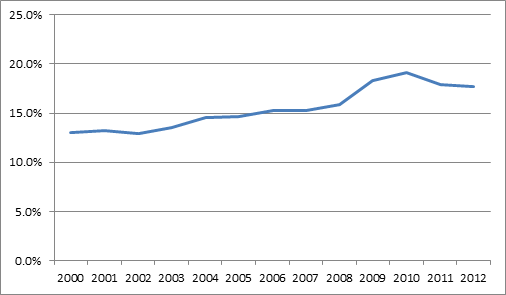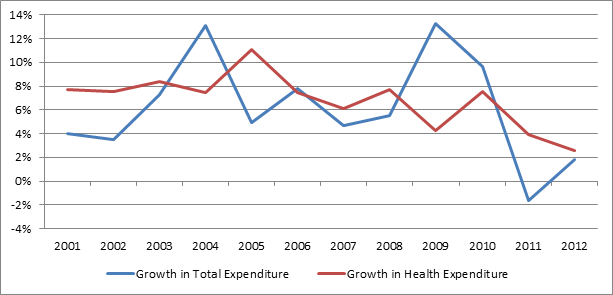Professionally, I am a killjoy. Most of my job involves explaining why education funding is not going to go back to the good times of the eighties any time soon. How bad things are going to get differs from place to place, and today I want to show you why I think there’s big trouble still ahead in Ontario.
Let’s start with the fact that government expenditures have risen sharply in recent years, as shown in figure 1. The Liberals held expenditures steady at about 15% of GDP until the recession hit and that number jumped to 18%. The government’s goal now is to reduce that amount – slowly – by freezing program expenditures at 118 Billion as of next year. If the Tories get in, you can be sure that they’ll be spending even less than that. So, unless you believe in an Andrea Horwath majority, the strong likelihood is that there is no new money coming into government coffers anytime soon. If more money is going to go into PSE, it will have to be at the expense of other budget priorities.
Figure 1 – Ontario Government Expenditures as a Percentage of GDP
The problem is that health care cost inflation tends to take precedence in the scramble for spare dollars in provincial budgets. In Quebec, for instance, healthcare’s share of the budget grows by about 0.75% each year – meaning it will break 50% of the budget sometime towards the end of this decade, with other budget priorities increasingly cast into the background.
Ontario, seemingly, doesn’t have this problem, with expenditures staying relatively constant around the 40% mark.
Figure 2 – Health and Long-Term Care Expenditures as a Percentage of Overall Budget Expenditures
The problem is, this is an illusion. Health expenditures have actually been going up by nearly 7% per year since 2001. The only reason health care hasn’t exploded as a share of the budget is because the Liberals have been increasing all spending by a similar amount.
Figure 3 – Annual Growth in Health Care and Total Budgeted Expenditures, Ontario, 2001-2012
But, as mentioned, the Ontario government is budgeting for zero growth in program expenditures through to 2018. Any increase in health care costs has to be met with cuts elsewhere in the budget. Indeed, if health care costs were to continue to rise at around 6% per year, that would mean cuts to the rest of the budget – including PSE – of roughly 22% by 2018.
Figure 4 – Implicit Ontario Budget Cuts, All Non-Health Budget Areas, Under Current Budget Caps and Various Health Care Inflation Scenarios
Maybe health care cost increases will be lower than 3% (even though that’s not happened in well over a decade). Maybe PSE will be spared its full proportion of the cuts. Maybe. But it seems to me almost impossible to construct a scenario where money for PSE increases. Cuts of 1-2% per year –enough to offset most of the potential gains from permitted tuition increases – seem much more likely.
Realistically, the only place Ontario universities are going to be getting any extra dollars over the next five years is international students. Plan accordingly.





 Tweet this post
Tweet this post
